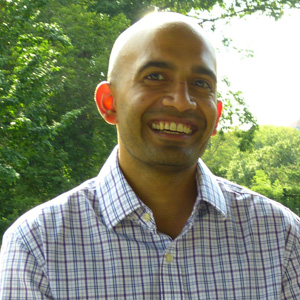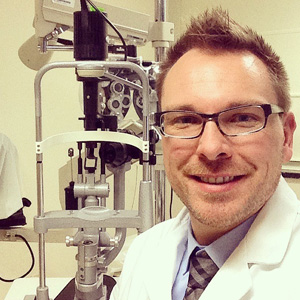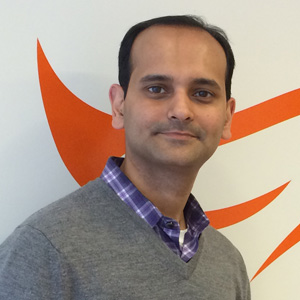Where Are They Now?

For some graduates, an advanced degree is one in a series of achievements on a predetermined course. For others, it's the launching pad for a surprising trajectory. Here four alumni tell us where they are and how they got there.
PLAYING "HOUSE"
Nikhil Mull, MD '08, assistant professor of clinical medicine and co-director, Center for Evidence-Based Practice, University of Pennsylvania

Many people think of general internists as doctors who push a lot of paper around, but I think what I've learned is that general internists are like the coach of the football team. They're calling the plays. It's up to the specialist to decide whether to run the play you called, but you are ultimately responsible for a lot of the decision-making.
I chose Brown for my internship and residency primarily because it was a very general internal medicine program, without a heavy focus on subspecialty rotations. At Brown, all the program directors are primary care doctors themselves or hospitalists, which very much fostered a breed of general internists who are excellent clinicians.
The nice thing is you get to do a little bit of everything along the way, and they give you time to explore your interests. After residency, I worked in one of their community health systems for a year as an attending hospitalist. I wasn't sure what I wanted to do. I was interested in four different specialties: intensivist, hematologist, oncologist or nephrologist.
In the end, I realized what I really wanted to do was general internal medicine, but in a way that included all those special interests. I joined Penn as a faculty member in clinical medicine. I'm also co-director of the Center for Evidence-Based Practice. We compare different treatments, protocols, processes, drugs and devices to help our health system make purchasing, policy and formulary decisions. Part of the center focuses on working with health care agencies to do this on a national level.
As a provider, I'm exclusively a hospitalist. That role includes a lot of the things I liked about other specialties. I particularly like the diagnostic element of my job. We are a pretty big referral center, so we have lots of patients coming in from other hospitals. We do a lot of diagnostic-dilemma work, and that can be fun, sort of like being a detective while being a clinician. We spend a lot of time with medical students and house staff. I tell people that my job is like the TV show "House," but I'm not as rude as Dr. House was.
While I was at Drexel, Dr. Miller and Dr. Boselli had a big impact on me. When I look back, I think, wow, how will I ever have as much knowledge about patient care as my mentors had? But now I'm in that role myself. I tell the students, this is what you have to do, here is how to stay on top of everything, and your patients will be very thankful for all that you put into their care.
ADVANCING ANIMAL CARE IN CANCER RESEARCH
Gillian Braden, MLAS '08, animal program veterinarian, National Cancer Institute, National Institutes of Health

I came to the Master of Laboratory Animal Science program as a pre-veterinary course, with the aim that I would eventually be doing laboratory animal medicine.
I got much more out of the program than I expected. Some of the coursework that we did in our first year — physiology and pharmacology, genetics, microbiology — all those classes were extremely valuable not only in vet school but even now at this stage of my career. Some of the laboratory animal science-based courses had information that I use to this day, including some of the basic biology of different species.
I graduated from Penn Veterinary School in 2012 and started a three-year residency program at the Tri-Institutional Training Program in Laboratory Animal Medicine and Science, which is a joint program of Memorial Sloan Kettering Cancer Center, Rockefeller University and Weill Cornell Medical College. I specialized in comparative medicine.
I joined the National Cancer Institute shortly after that. We have a large institution for animal work, and I'm involved with the clinical care of those animals, monitoring compliance, and post-approval monitoring of animal study proposals. I consult with principal investigators and help them design experimental studies. I conduct training for staff members on anything from basic animal handling to surgical skills. I also teach American Association for Laboratory Animal Science certification classes for staff, review guidelines and SOPs for the institution, and support any research on animals from the NCI and occasionally other NIH institutions.
I mainly focus on basic discovery and preclinical research. Some of our PIs are physicians who do clinical work for NIH and do animal studies as well. I help them design experimental protocols, ensuring that that they are using the best animal model for the type of cancer they're studying and that they have the correct humane endpoints for that model.
I've always been a big advocate for transparency in the use of animals in biomedical research, and I dedicate my life to making sure that the animals are treated humanely. Not everyone involved in the care of laboratory animals is a veterinarian, but there are animal caretakers, research technicians, veterinary technicians, quality-assurance people, trainers — so many people who are dedicated to caring for research animals as humanely as possible. Most people are unaware of all the care that goes into this field.
FINISHING 29TH GRADE
Paul Phelps, MD '10, ophthalmologist and ophthalmic plastic and reconstructive surgery fellow

When I was in medical school, I spent a year on a Fulbright at Aravind Eye Hospital in Madurai, India. I had heard of oculoplastics, but that was my first experience with it.
After my internship, I did a three-year ophthalmology residency at Cook County Hospital in Chicago, a very clinically oriented program. I did around 300 cataract surgeries, which is a lot for a residency program. From there, I went to the opposite end of the spectrum, to a very academic eye pathology fellowship with Dr. Daniel Albert, who's one of the gurus of eye pathology and ophthalmology in general.
Now I'm at the Albany Medical Center Eye Clinic doing a two-year oculoplastics fellowship. The technical term is ophthalmic plastic and reconstructive surgery. I'm a board-certified ophthalmologist, but there's a second set of exams, and a thesis, for membership in the American Society of Ophthalmic Plastic and Reconstructive Surgeons. So I'm not quite finished my medical education.
The three main things that we talk about within oculoplastics are orbit, lacrimal and lids. The procedures range from bone surgery of the eye socket (if a patient has a lacrimal gland tumor that needs to be removed, for example) to repairing the tear drainage system to eyelid reconstruction.
People in oculoplastics can do any facial cosmetic surgery as well. I offer Botox for people whose eyelid muscles spasm uncontrollably or who have hemifacial spasm. We also do cosmetic Botox and fillers, blepharoplasties and sometimes even full facelifts.
Plastic surgeons will refer their patients to us, as will ophthalmologists and dermatologists, because they don't want to go near an eye with skin cancer. We do quite a few skin cancer reconstructions. Sometimes the patient's whole eyelid is involved; that requires a lot of creativity, because every case is different. My day can be a lot of different things. I see neonates and 100-year-old patients.
I also enjoy the research aspect of the work. I have about 23 publications to my credit now, and when I finish my thesis and exams, I'll work as an assistant professor or an associate professor at NorthShore University HealthSystem, where I will be teaching University of Chicago residents.
I like helping residents who are interested in ophthalmology, and in oculoplastics specifically. It's not an easy field to get into, so I like to be a mentor to residents. It's really enjoyable when you have somebody who's motivated and asks good questions. It makes me think critically and helps me to improve my own practice.
When anyone asks what I do, I tell them I'm in 29th grade, but I'm looking forward to finally joining the ranks of the employed.
DRIVING RESEARCH FOR PARKINSON'S DISEASE
Kuldip Dave, PhD '05, director of research programs, Michael J. Fox Foundation

With my PhD in pharmacology and physiology, I completed a three-year postdoctoral fellowship studying opioid receptors and developing in vivo and in vitro models of pain at Adolor, a small biotech. I went on to work for Wyeth Research, where my primary function was to drive the drug discovery program in women's health for mood disorders, which suited my background in neuropharmacology.
After Wyeth was acquired, I wasn't sure what I wanted to do next. I was curious what a scientist with my qualifications and expertise does in a nonprofit foundation. I had an informational call with someone at the Michael J. Fox Foundation, who told me about his job and what kind of impact he was having on research. It seemed very enticing. He hired me three months later.
My education has allowed me to fit myself into different therapeutic areas. Now, my single focus is on Parkinson's disease, but the challenges for drug discovery in Parkinson's are common to other neurological disorders — a lack of biomarkers and the need for long clinical trials because of the heterogeneity of the disease.
As director of research programs, I oversee about $25 million of our portfolio, which includes two of our largest priority areas, alphasynuclein and GBA [glucocerebrosidase]. "Priority areas" means that instead of waiting for the research community to come to us, we lay out the strategy and develop groups that are working on a particular challenge.
About 50 percent of my job is scientific research management. I identify gaps in research, identify challenges in drug development, and build a strategic roadmap by which we can fill those gaps. Once we fund a program, I essentially become a scientific manager for that grant.
Right now, I manage about 85 grant projects. I write the milestones, have calls with the investigators and determine if the milestones are met. Having milestone-based payments allows us to troubleshoot the project and work with the awardee if it needs to be modified or if we need to take another path.
I've been managing alpha-synuclein for six years now. When I started, there was not a single therapeutic in the clinic. They were all in the early preclinical stages in drug discovery. These programs needed the foundation's support, so we formulated request-for-application calls. We funded about 40 different programs, and I'm happy to say that three of those programs have now entered the clinic.
Another part of my job is developing and maintaining relationships with government agencies and other nonprofits. I also work with contract research labs to develop our portfolio of research tools. That way, we control the quality of a tool and its distribution. We can make these resources available to everybody, so it's not cost prohibitive to conduct this important research.
As a student, you never quite know where your path is going to take you. I went from graduate school to a small biotech to a large pharma to a nonprofit, none of which I could have predicted. There are many ways to get to the top of the mountain, and you find your own way to do it.
Back to Top